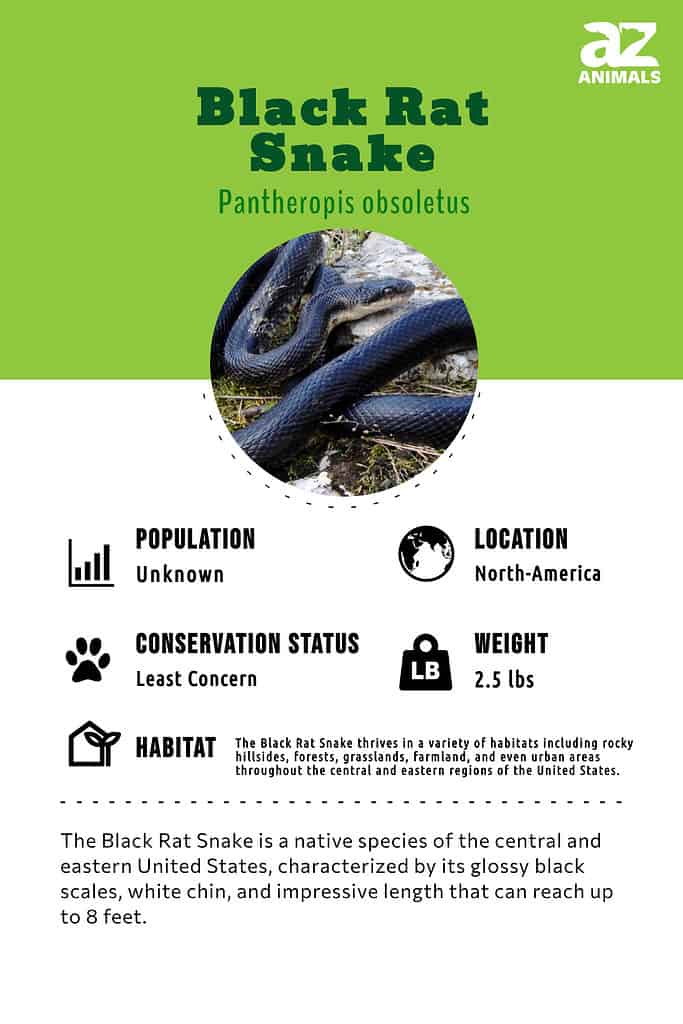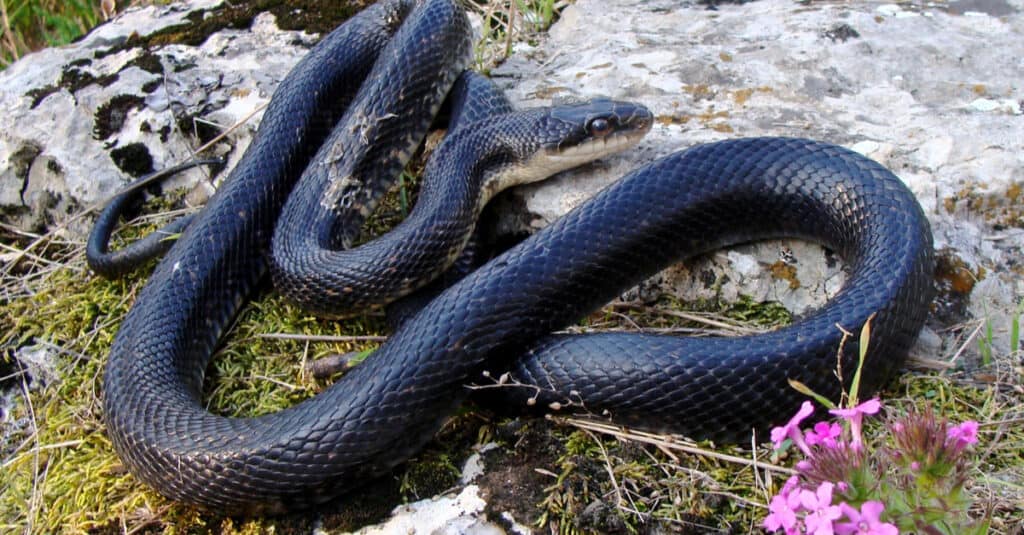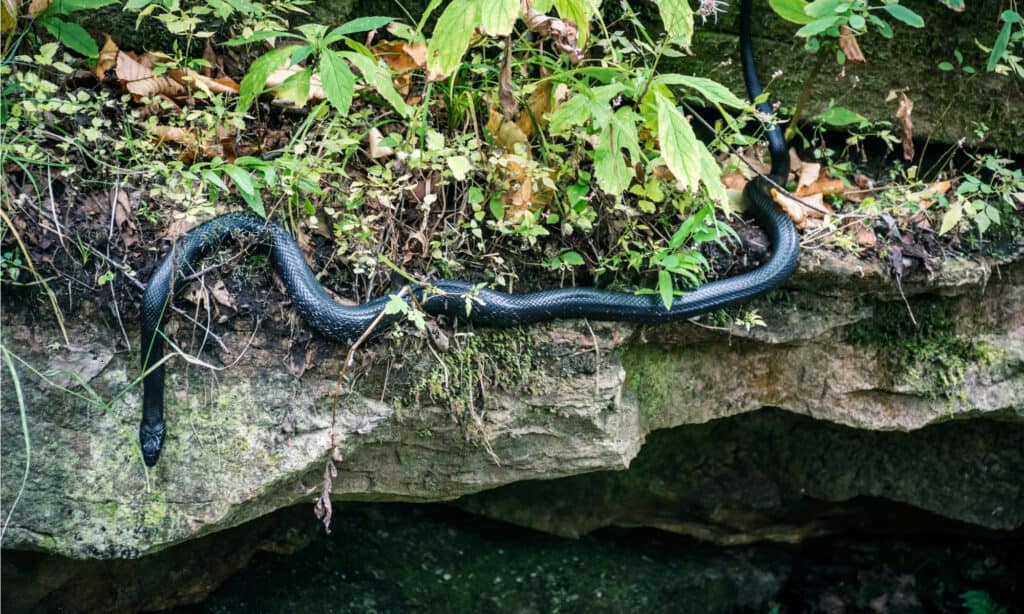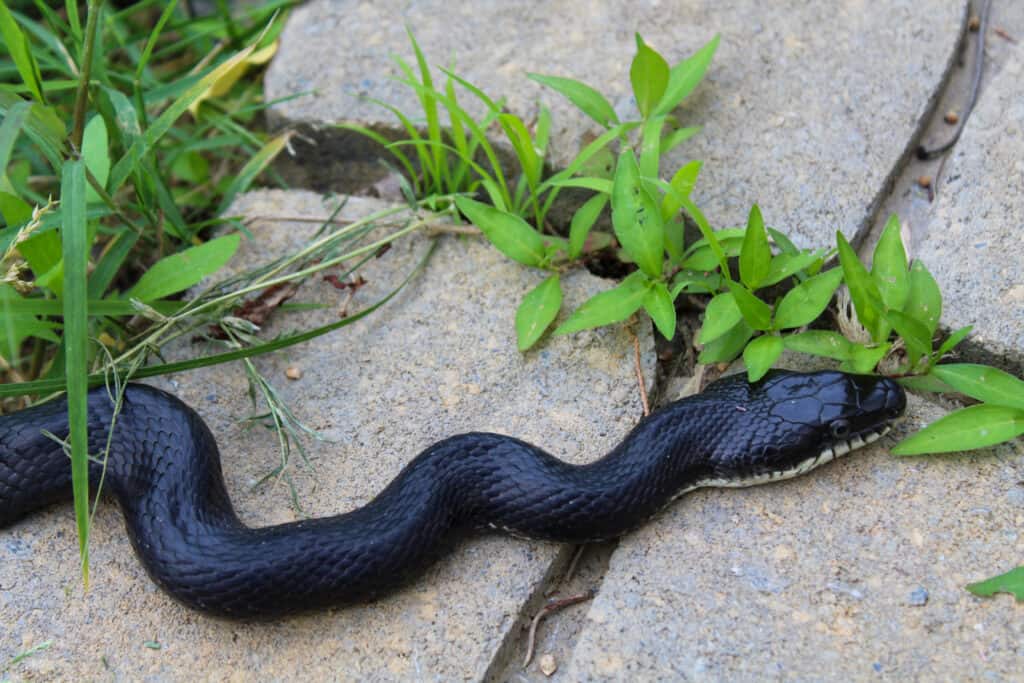Black Rat Snake
Pantheropis obsoletus
They're also called black pilot snakes due to a myth that they "pilot" venomous snakes to a den where they can go into brumation for the winter.
Advertisement
Black Rat Snake Scientific Classification
- Kingdom
- Animalia
- Phylum
- Chordata
- Class
- Reptilia
- Order
- Squamata
- Family
- Colubridae
- Genus
- Pantheropis
- Scientific Name
- Pantheropis obsoletus
Read our Complete Guide to Classification of Animals.
Black Rat Snake Conservation Status
Black Rat Snake Facts
- Prey
- Mice, frogs, birds, eggs
- Fun Fact
- They're also called black pilot snakes due to a myth that they "pilot" venomous snakes to a den where they can go into brumation for the winter.
- Estimated Population Size
- 100,000
- Most Distinctive Feature
- Adults have shiny black scales on its back along with a gray or tan belly in a checkered pattern and white on their chin and neck
- Distinctive Feature
- Thick powerful bodies
- Other Name(s)
- Western rat snake and the pilot black snake
- Habitat
- Farmlands, rocky areas of land, hillsides, and forests
- Diet
- Carnivore
- Common Name
- Black Rat Snake
Black Rat Snake Physical Characteristics
- Color
- Brown
- Grey
- Black
- White
- Skin Type
- Scales
- Length
- 3.5 - 8 feet
- Venomous
- No
- Aggression
- Low
View all of the Black Rat Snake images!

At eight feet, black rat snakes are one of the longest snakes living in North America.
Black rat snakes are native to the central and eastern portions of the United States including South Carolina, Ohio, Kentucky, and other states. They are carnivores with a diet of mice, frogs, birds’ eggs, and, of course, rats. This reptile spends its wintertime brumation in a den with other types of snakes. A juvenile has a pattern of gray and black scales but gradually becomes all-black as it grows into an adult.
4 Amazing Facts

It demonstrates exceptional climbing skills and occasionally seeks refuge within the crevices of tree trunks.
©Matt Jeppson/Shutterstock.com
- It’s sometimes called a pilot snake because of the mistaken belief that it guides venomous snakes to a suitable den in the winter
- It is an expert at climbing trees and sometimes hides in the crevices of a tree trunk
- When it’s agitated this snake may shake its tail as a warning to a predator to retreat
- It’s valued in Ohio as a snake that helps keep the rodent population under control
Evolution and Origins
Pantherophis obsoletus, commonly referred to as the western rat snake, black rat snake, pilot black snake, or simply black snake, is a nonvenomous member of the Colubridae family. This species is indigenous to central North America and does not have any recognized valid subspecies.
Black rat snakes originate from the central and eastern regions of the United States, adapting to diverse habitats such as rocky hillsides and flat farmland, and exhibiting adaptability to a broad range of elevations.
Visitors to the Maryland Zoo in Baltimore can observe black rat snakes in the Tree exhibit within the Maryland Wilderness area.
Where to Find Them

These serpents originate from the central-eastern region of North America within the United States.
©Realest Nature/Shutterstock.com
These snakes are native to the central-eastern portion of the United States in North America. They are especially plentiful in Ohio and Missouri. Notably, the black rat snake is one of two black snakes in South Carolina that grow to be five feet or longer.
These snakes can live in a number of different habitats including farmlands, rocky areas of land, hillsides, and forests. These reptiles occupy areas with a temperate climate. This means they have to go into brumation in the winter months when it gets cold. Generally, they begin to go into brumation in the month of October and stay in their shelter until March.
A widespread myth about this snake relates to its wintertime brumation. It’s sometimes called a pilot snake. The myth goes that these snakes pilot venomous snakes to a den where they can go into brumation for the winter. Though these snakes sometimes share a den with venomous snakes in the wintertime, they don’t serve as a guide for snakes in search of a den!
These snakes are especially active in the spring and summer seasons. They begin breeding in April and May. They’re great climbers, so they’re often spotted in trees in pursuit of prey.
Scientific Name

The scientific designation for the black rat snake is Pantherophis obsoletus.
©Andrew F. Kazmierski/Shutterstock.com
Pantherophis obsoletus is the scientific name of the black rat snake. It’s also known as the western rat snake and the pilot black snake. The Latin word Pantherophis translates to “predator of all snakes.’”Generally speaking, this means it’s a snake that hunts a variety of prey.
The Latin word obsoletus translates to the phrase “falls into disuse.” This refers to the fact that it loses its juvenile color pattern as it grows into an adult.
Its family is Colubridae, and it belongs to the Reptilia class.
Population and Conservation Status
The IUCN Red List of Threatened Species reports the population of adult black rat snakes as at least 100,000. They have a status of Least Concern, and their population is described as stable.
Appearance and Description

A fully grown black rat snake displays glossy black scales on its dorsal side and a checkered pattern of gray or tan on its ventral side.
©samray/Shutterstock.com
An adult black rat snake has shiny black scales on its back along with a gray or tan belly in a checkered pattern. In addition, adults have white on their chins and necks. Baby and juveniles, on the other hand, have a pattern of black and gray blotches. These gradually turn black as the snake becomes an adult.
The size of this snake can vary, but they range from three and a half to eight feet long. A juvenile measures about one foot long as it emerges from its egg. This snake also has a thick, powerful body.
How to identify a black rat snake:
- Adults are black with a gray or tan checkered belly
- Adults have white under their chin and neck
- Baby or juvenile snakes have a gray and black pattern of scales
- Round, dark pupils
Black Racer vs Black Rat Snake

Black racers are often mistaken for black rat snakes.
©ButtermilkgirlVirginia/Shutterstock.com
If you saw a black racer and a black rat snake in a forest or grassland, you may think they are one and the same. After all, these two black snakes are long and look incredibly similar even at close range. For instance, both the black racer and the black rat snake eat rodents, birds’ eggs, and amphibians.
Both species have round pupils. Plus, they’re both climbing snakes though the black rat snake climbs trees and the black racer climbs shrubs and bushes. So, with all of those similarities, what are the differences?
One of the most remarkable differences between these snakes relates to their body size. The body of a black racer is more like a narrow whip whereas the body of a black rat snake is thick. In terms of length, the black racer can grow as long as six feet while the black rat snake can measure up to eight feet.
The scales on these snakes are another feature to take into account. The scales of a black racer have a flat tone while the scales of a black rat snake are shiny.
Their behavior is another thing to observe when trying to differentiate these two snakes. Black racers are aggressive and nervous. Alternatively, black rat snakes are docile with a mild temperament.
Black racers bite their prey and swallow it whole. Alternatively, black rat snakes are constrictors squeezing their prey until the animal is dead. Then, the snake starts the process of swallowing it. If you’ll notice, a black racer’s body is not thick or strong enough to constrict its prey.
How Dangerous Are They?
The black rat snake is not poisonous. It kills its prey by constricting its body like a boa constrictor or a python.
Of course, it can still bite a human if it feels cornered. The first thing to do if you get a bite from a black rat snake is to clean the wound with soap and warm water.
Next, put first-aid cream or ointment on it. After that, put a clean bandage over the wound and watch for redness or a rash that can signal infection. If these symptoms appear, it’s best to see a medical professional to treat the infection.
Behavior and Humans
Sometimes these snakes take refuge from the heat in barns or stables on farms. But keep in mind these are shy, non-aggressive snakes and would much rather avoid people.
Interestingly, black rat snakes have a few defenses if they feel threatened by a human, a dog, or another predator. For example, this snake can freeze. This means it crinkles or kinks its body to make itself look like a crooked stick on the ground. Clever snake!
This snake may also release an odor to discourage a threat from approaching it. In addition, these snakes are known to shake their tails as a way to warn any threatening predator to move away.
View all 285 animals that start with BBlack Rat Snake FAQs (Frequently Asked Questions)
Are black rat snakes venomous?
No, these snakes are not poisonous.
How do black rat snakes hunt?
Black rat snakes climb into trees to steal birds’ eggs or baby birds out of nests in order to eat them. Also, these snakes stalk rats, mice and other rodents and amphibians through the tall grass. Once this snake grabs onto its prey, it wraps its strong body around it until the animal stops breathing.
Are black rat snakes aggressive?
No. Though the tremendous size of this snake is imposing, they are not aggressive.
100,000
They are native to the central-eastern part of the United States in North America. This includes South Carolina, Kentucky, Ohio, and Missouri along with other states.
What do black rat snakes eat?
They have a diet of rats, mice, frogs, and birds’ eggs.
Do black rat snakes bite humans?
They can bite humans but are more likely to freeze or try to get away.
Are black rat snakes harmless?
Yes and no. These snakes are able to bite humans, but they are not poisonous.
Are black rat snakes friendly?
No. They are shy and don’t want to interact with humans.
What are the differences between copperheads and black rat snakes?
The major differences between copperheads and black rat snakes are in their looks and their modes of attack and defense. Black rat snakes are bigger and heavier than copperheads.
Thank you for reading! Have some feedback for us? Contact the AZ Animals editorial team.
Sources
- Seaworld, Available here: https://seaworld.org/animals/facts/reptiles/black-rat-snake/
- IUCN Red List, Available here: https://www.iucnredlist.org/species/90069553/90069569
- Maryland Zoo, Available here: https://www.marylandzoo.org/animal/black-rat-snake/
- Chatt Nature Center, Available here: https://www.chattnaturecenter.org/visit/experience/wildlife/animal-facts/black-rat-snake/
- Ohio History Center, Available here: https://ohiohistorycentral.org/w/Black_Rat_Snake
- South Carolina Department of Natural Resources, Available here: https://www.dnr.sc.gov/wildlife/snakes/snakes4.html
- University of Kentucky College of Agriculture, Food and Environment, Available here: https://oepos.ca.uky.edu/content/black-rat-snake

















